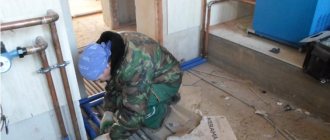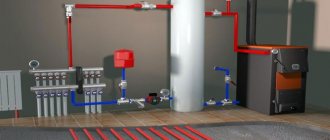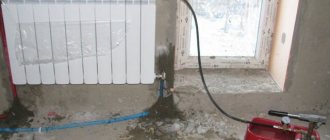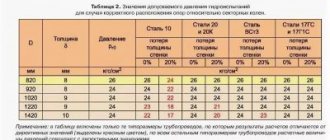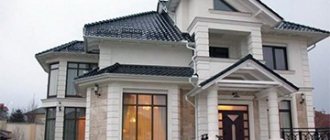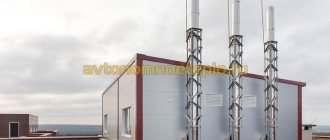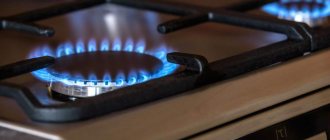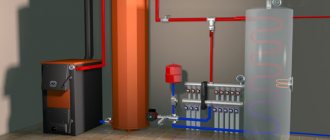Home / Heating /
Many sites offer heating design, but there are only 1 competent specialists for every 7 people. I have been designing heating for 9 years and will tell you what a high-quality project looks like and what issues it addresses. Why are projects in design companies most often expensive and stupid, but installers are ready to complete the project for free?
On this page you will find out how much the project costs, what initial data is needed, decide on the type of system, type of radiators and understand how to visually distinguish a high-quality project from design sketches. I will show you my projects and tell you the correct order of work. I’ll tell you what questions to ask companies and what to pay attention to.
- Bimetallic
Good afternoon My name is Alexey Goltsov. Heating system design engineer. I have been designing heating for 9 years. Education – MGSU-MISI, direction “Heating and Ventilation”.
Specialization – private houses, offices, restaurants, industrial buildings.
In a team of 5 designers, I carry out projects of internal engineering systems: heating, boiler room, water supply, sewerage, ventilation and electrical.
Unlike designers in companies, you can work with me directly. Solve any issues without intermediaries and a “broken phone”. And the correct order of work will allow us to discuss all issues in advance and not miss anything. I worked in installation companies, so according to my project you can purchase all the necessary materials and get a working system.
I carry out projects throughout Russia, taking into account the climatology of your construction region.
Composition of the heating project
Total information
General data helps you quickly navigate the drawings, understand the source data and key decisions of the project.
In general data we indicate: climatic parameters, water temperature, type of heat supply source, type of heating system, brand of radiators and installation requirements.
Thermal calculation
Thermal engineering calculation (heat loss calculation) allows you to accurately select radiators for a specific building. Find out their power and size. The calculation takes 6 hours and saves the Customer from 70 thousand rubles.
In the calculation, we take into account the region of construction, the material of the external walls, the brand of windows, the thickness of the insulation, the presence of heated floors and orientation to the cardinal points.
It looks like this: calculation file .
Many companies do not perform heat loss calculations. Radiators are selected on average. As a result, the Customer overpays for the equipment.
Heating system plans
Builders need heating plans to properly assemble, run and balance the system.
On the plans we indicate: the placement of radiators, their size and power; pipe installation locations, water size and flow rate; placement of heating risers; location of manifold cabinets, their size and brand.
We determine heat loss in each room and select heating devices. We indicate their brand, size, power. Next, we calculate the diameters of the pipes and their correct routing, but that’s not all.
Floor heating system plans
I include the calculation of underfloor heating in the cost of the heating system. On the plans we indicate the length of the circuits, the pipe laying pitch and the pressure loss in each circuit.
Many experts choose the laying step and pipe size arbitrarily. This leads to overheating of surfaces, constant shutdown of floors and subsequent failure of servos.
If the designer does not calculate the balancing of the heating circuits, some zones will always be overheated, while others will be cold.
Many companies provide underfloor heating as a separate section, so the cost of a heating project seems less.
Hydraulic calculation of pipelines
We choose the size of the pipelines based on the power of the radiators, water flow and speed, but this is not enough. Pipe routing and diameters may be incorrect.
Most companies do not perform hydraulic calculations.
In order for each radiator to receive the required volume of coolant, it is necessary to perform a hydraulic calculation of the heating system. Based on the results of the calculation, we will change the heating system, clarify the routing and diameters of the pipes. We will connect some radiators to a common pipeline, and some to a separate one.
How does hydraulic calculation work?
In the calculation, we will determine the pressure loss at each section of the network. We know that water moves along the path of least resistance. But it is important for us to select the diameters and routing so that the resistance of sections of different lengths is approximately the same. This way the coolant will be distributed evenly across the radiators, and the system will work correctly.
I perform hydraulic calculations in MagiCAD. This program flags unbalanced areas and suggests adjustments.
Heating and underfloor heating schemes
Heating diagrams give an idea of the vertical sections - risers, and help take into account the places where pipelines intersect with each other.
On heating and underfloor heating diagrams we indicate: an isometric view of the system (3D); pipe sizes, radiator brand and power; places where pipelines intersect and lay vertical sections.
Specification of equipment and materials
It often happens that a specialist designed the system correctly and calculated the specification incorrectly.
Specification calculation is the most important stage of the project. Based on the drawings, we calculate the required amount of equipment and materials. We provide a table with a complete list of everything needed.
As a result, an error in quantity will lead to a shortage or excess of materials. An error in the article means purchasing the wrong equipment.
The most common errors in specifications
I will list the main ones: the type of connection of radiators is incorrectly indicated; the side connection is confused with the bottom; the collector unit is indicated without thermostatic inserts; errors in the number of radiators and their sizes.
Prices for heating design
| Name of works | Explanations | Unit. | Price |
| Heating system design with thermal calculation (for a house up to 100 m2) | The project includes:
| set | 6000 rub. |
| Thermal calculation | Calculation of heat losses of a building. | per 1 m2 of building area | 20 rub. |
| Heating system design | The project includes:
| per 1 m2 of building area | 60 rub. |
| Design of an underfloor heating system | The project includes:
| per 1 m2 of building area | 45 rub. |
| Complex project of engineering systems | The project includes:
| per 1 m2 of building area | 120 rub. |
Issues that we solve in a heating project:
- What power does the boiler need? Solution: In 90% of cases, gas services recommend boilers with a huge reserve. A correct calculation of power is required, taking into account all consumers.
- What size radiators should I choose for each room? Solution: Construction companies do not make calculations and select radiators with a 30-40% margin. For a house of 200 m2, this overpayment is approximately 70,000 rubles. We need a calculation.
- Which brand of radiators should I choose? Which one will be optimal in terms of price, efficiency and appearance? Solution: Builders often recommend radiators that they are used to working with and for which they have the maximum discount. I discuss radiator brands with Customers. Comparison of radiators. How to choose?
- Which pipe to choose from the 4 types? What are their differences? Solution: We select pipes depending on the location of their installation, the availability of various diameters and the temperature of the coolant.
- Which brand of pipe should I choose? What are the diameters? Solution: There are a lot of good and inexpensive analogues on the market. There is no need to put Rehau everywhere if you have Stout. Need optimization. The size of the pipes must be calculated.
- Where should manifold cabinets be located? Size, brand, cost. Solution: You need to choose the optimal location, which is suitable not only in terms of ease of installation but also in design.
- Which pumps, mixing units, expansion tanks, combs and hydraulic arrows should I choose? Solution: We need to select boiler room equipment.
- What is the best way to install a chimney on the roof? What types of chimneys are there? Is it possible on the facade? Solution: We select chimney options, calculate the size, height and type of chimney in the boiler room project.
- Which type of radiator connection should I choose from the 3 options? Solution: Discuss options with the Customer and agree.
- Is it possible to heat houses only with underfloor heating? Solution : Calculate underfloor heating and heat loss, compare the values for each room, and draw a conclusion.
- Which rooms need heated floors? Solution : Discuss with the Customer and agree. If there are less than 3 circuits on the floor, do not use warm water floors. Recommend alternative options.
- What pipe laying step is needed, how many pipes, transitions, tees are needed? Solution : High-quality heating design.
How equipment is selected
When developing a heating system project for a private home, we select equipment according to the specified parameters and within the allocated budget. When choosing a boiler, we pay great attention to energy efficiency, taking into account the type of fuel used, the total area of the premises and the wishes of the Customer. It is also important to choose the right harness for it. The piping system includes an expansion tank, drain and ball valves, a pump, a distribution valve and other devices.
Another point when designing heating in a private house is determining the installation location of the heating boiler. In particular, the need to install a separate boiler room is taken into account. The premises must comply with current norms and standards. In addition, our specialists determine how the pipes will be laid and where the heating radiators will be installed. It is extremely important to accurately link these elements of the system in order to achieve flawless functioning.
It is possible that there may be a need for additional insulation of the house, which will reduce energy consumption. To do this, the type of building materials that were used in the construction of the building, the size of heat loss points (doors, windows, etc.), as well as the orientation of the rooms to the cardinal points and the functional purpose of each room are taken into account.
What will the Customer have to face?
Many companies are happy to work without a project. Once the project is completed, it becomes difficult for installers to “make money” and sell something unnecessary. The customer sees every item in the estimate and can compare it with the project. Ask to find cheaper analogues.
With the finished project, the Customer will receive a complete list of materials and can compare prices in different companies for the same amount of work.
In order not to lose a Customer who requires a project, companies offer to do a heating project for free or for a nominal 10,000 rubles.
In such projects, companies most often include equipment that is profitable for themselves, which is selected on an average basis. There is no time for full calculations, so the power of the equipment is chosen with a large margin. As a result, the customer overpays for the useless size of radiators, pumps and boiler by 3-4 times more than he saved on the project.
Always request a thermal engineering calculation. It takes 6 hours and guarantees that the equipment is selected correctly.
The main advantages of heating design: why do you need it and why do we need it?
A correctly completed heating project is important not only for installers, who of course find it much more convenient to work according to clear diagrams, but also for home owners, who, even before the start of installation work, will know exactly the total cost of the heating system, that all work will be carried out according to standards, and the heating of the house will work like a clock. To be sure of the quality of the project, the work should not be trusted to private contractors from numerous sites, and certainly not to friends or relatives. You need to make a decision on choosing a contractor based on the following important and objective indicators:
- Opportunity to conclude a formal contract. The design of a heating system is a responsible task, which in one way or another affects not only the cost and performance of the future system, but also the safety of residents. The contract legally binds you and the contractor and provides certain guarantees that the designer will complete everything efficiently and on time.
- The contractor has a portfolio of actually implemented systems, and not just hundreds of projects drawn on paper that were never implemented. By ordering a project from a private designer who has given the minimum price, you are almost guaranteed to receive a standard, simple project and a set of materials, slightly adjusted to the dimensions of your home. Whether the heating system will work properly in your home is actually a lottery. The company and the private owner cannot be responsible for the quality. And if you trust a relative, it will most likely turn out like in the expression “If you want to lose a friend, sell him a car,” which we have observed more than once in our practice.
Heating project cost
Installation companies often complete a project for 10,000 rubles.
The main cost of the project is included in the installation price. The work of an experienced designer is expensive, so projects in installation companies are usually carried out by novice specialists. Thermal and hydraulic calculations are not done, because it is long and laborious. Equipment is selected “by eye”.
As a result: The customer overpays at the installation stage by 3 times more than the cost of a high-quality project and risks getting an unbalanced system.
The purpose of the editing room. Therefore, the project is cheap, and the proposed solutions will be more expensive to implement.
In my work I represent the interests of the Customer.
My cost for design work:
Project cost calculator
Design timeframe
The design time frame directly depends on the approval stage, so I will indicate the work time frame without taking into account the time for discussing design decisions.
For private houses:
Draft design from 3 (100m2) to 8 (500m2) working days; Working project from 5 (100m2) to 16 (500m2) working days.
The average design time for heating in a cottage takes 14-20 working days. This period includes all calculations, approvals, heating design, underfloor heating and boiler room. If you have already collected all the initial data, the design period is 5-10 working days.
For offices, shops, restaurants:
Draft design from 2 (100m2) to 16 (2000m2) working days; Working project from 3 (100m2) to 20 (2000m2) working days.
Which system should you choose?
The design of the heating of a private house is carried out taking into account the energy carrier that will be used to heat the room. There are several most common systems through which heat is supplied to all interior spaces of a building:
- water;
- air;
- electric;
- open fire.
An “open fire” means a fireplace hearth or stove. Both of these heat sources are ineffective in providing full-fledged home heating, as they distribute hot air unevenly. They are most often included in a heating project as decorative elements. Let's look at other systems in more detail.
How companies work. What is the problem?
When I worked in design companies, half of my time was spent adjusting old projects. We got the job done quickly. We handed over the project to the Customer, and then corrected it 10 times. First there were comments from the designer, then from the builder, then from the Customer. At some point, the builder’s comments contradicted the Customer’s comments, and the circle was closed.
Company operation scheme
In a design company, a heating project costs from 70,000 rubles and will be much more thoughtful than that of installers. But there is another problem:
Design companies do not discuss their decisions with the Customer. When the time comes to install, questions arise about the project. Deadlines are getting delayed.
Companies do not take into account that after the completion of the finished project, the Customer or the builder will certainly have wishes. Making changes to a finished project delays deadlines, costs money and leads to errors. One adjustment entails a whole list of changes.
As a result: The designer in the company recalculates the specification several times and is sure to make mistakes, and the installer purchases the wrong material, which finally stops construction and leads to conflicts.
The solution to the problem lies in the correct organization of work.
What is included in the project?
Professionally drawn up project documentation should include the following items:
- company letterhead with seal;
- organization license;
- explanatory information about the project points;
- a detailed plan for routing highways (including high-rise ones);
- estimate;
- instructions for performing work;
- specification of materials and equipment;
- project sketch;
- drawing detailing all components of the heating main;
- plan for wiring communications and connecting nodes.
Heating scheme
There are two main types of heating systems - single-pipe and double-pipe.
- In a single-pipe system, the coolant moves along a ring consisting of one pipe, to which radiators are connected in series.
- In a two-pipe system, the hot coolant is supplied to the radiators through one pipe, and the cooled coolant is discharged to the boiler through the other.
The single-pipe system has two major disadvantages, so it is rarely used in private construction, despite the insignificant savings in pipes.
The disadvantages are as follows. The coolant cools down, so the last radiator is much colder than the first. Therefore, the system cannot be extended, it is applicable in small houses, and the last radiators must be of greater power to equalize the heat output.
Changing the operating parameters of one radiator affects others. It is difficult to configure the selection of the required thermal power for each radiator.
Two-pipe systems
There are several types of two-pipe radiator circuits.
- Sequential (passing circuit) - all radiators on the same floor are connected to one supply pipeline and one return line. The scheme is the most stable, does not require adjustments, and is applicable in the largest houses.
- Dead-end (wing circuit) - all heating is divided into several arms consisting of two pipelines - supply and return, between which radiators are connected in parallel. The scheme works great in small houses, provided the shoulders are equal.
- Beam (collector circuit) - pairs of pipelines depart from the collector to each radiator. There is a disadvantage in the complexity of laying pipes, and the complexity of setting up distribution in the manifold. But the system can be quickly controlled from one place, and all pipes are of small diameter. It is used provided that the collector is installed in the center and all connections are equal.
Usually, for a private house, they choose a ride if the house is large. Or a dead-end with heating divided into 2 or several identical arms for a small house, which allows reducing the diameters of the main pipelines.
As you can see, understanding the choice of the main parameters of the heating system is not so difficult. The decisions made also determine the choice of all technical means of the heating system.
How I work. Work order
I work according to the following scheme:
My scheme of working with customers
Filling out the questionnaires
I ask you to fill out the Questionnaires. This will help collect initial data and take into account wishes. I understand that the Customer is not a specialist, so we fill out the questionnaires together.
We develop a preliminary design
To take into account the wishes of the Customer, designers and builders, we first develop sketch plans of the systems. In a simplified way, “in one line” we indicate pipes and the placement of key equipment. In order to approve fundamental decisions, we send a preliminary design to all construction participants. We correct sketches for free until complete approval.
We are developing a working draft
We don't redo a project 150 times. We discuss all key decisions at the Draft Design stage. Strictly according to the Draft Design, we carry out the Working Design once and hand it over to you. The project immediately goes into editing, because... We previously discussed key decisions and took into account wishes.
Initial data for design
To start design work we will need:
- Architectural design of the building;
Architectural plans of the building
2. Completed questionnaires with answers:
- Exterior wall pie, window material;
- Region of construction;
- Orientation of the building to the cardinal directions;
- Height of window sill spaces (for placing radiators);
- Selection of heating devices (discussed at the design stage);
- Selecting a heating scheme depending on the type of building;
- Determination of warm water floor zones, etc.;
All questions in the file:
Questionnaire section Heating
Questionnaire section Boiler room
Main elements of the heating system
A heating system that can operate autonomously consists of a huge number of different elements. In order to clearly understand and imagine the principle of operation of such a system, you should understand the purposes and operating principle of its individual components.
Boiler
The boiler is the most important part of any heating system, since it is in it that fuel combustion occurs and heat is generated. Today, two types of boilers are manufactured, which differ from each other in their functional features: single- and double-circuit. These are the types that are used in most projects of private houses with a boiler room.
Single-circuit boilers can perform one single function - heating the house, while double-circuit boilers can also heat water. Despite the fact that a double-circuit boiler is more popular, it is considered less reliable than a single-circuit boiler. The reason is this: if the double-circuit boiler fails, the entire house will be left not only without heat, but also without hot water. If a single-circuit boiler fails, the house will be left without heat, but a small supply of hot water will still be present.
The difference between single-circuit and double-circuit boilers
Double-circuit boilers are equipped with special devices that heat the water, while in single-circuit devices it is heated directly in the boiler itself, then moves through the radiators, and then returns to the boiler.
Depending on the type of installation, boilers are divided into floor-mounted and wall-mounted. Hanging boilers, which mainly use gas atmospheric burners, are much better adapted to fluctuations in gas pressure in main pipelines (since floor-standing boilers fail much faster in such situations).
Installation diagram of a single-circuit wall-mounted heating boiler
Universal boilers
Such boilers allow the use of almost any type of fuel, but the most efficient will be a specialized boiler, for example, for solid fuel or for heating with diesel fuel. The heating supply project must show the home owner what the operating efficiency of different boilers is, how much gas, coal, firewood or diesel fuel will cost.
Of course, universal boilers may seem like outdated devices to some, but fuel industry technologies are constantly evolving. For example, a boiler that is designed for special fuel briquettes is a high-tech and environmentally friendly heating system. Of course, there will be smoke and other products of wood combustion, but everything is not as critical as it was in London in the 18th century, when the sky was not visible from the smoke of fireplaces. Technologies have changed quite seriously.
Technical task
“Without technical specifications, the result is technical specifications”
Most companies write a formal Statement of Work. Copy standard text into different projects, changing the headings.
I have a different approach to the Technical Specifications.
As part of the technical specifications, we discuss the main solutions and brands of equipment, taking into account the wishes of the Customer, so as not to redo the finished project later.
There are at least 2 heating schemes, 5 types of radiators, 3 ways to connect them, 4 types of pipes and a huge number of manufacturers. We must discuss all these nuances with the Customer and write them down in the Technical Specifications. Every person has wishes for the project. You need to communicate and ask the right questions.
An example of my Terms of Reference is here .
Boiler room design
A boiler room is not just a separate project. This is a separate world with its own pumps, expansion tanks, hydraulic guns and automation.
All this equipment must be correctly calculated and selected.
There are no typical boiler room projects. Boiler manufacturers change automation and update equipment every six months. Therefore, old projects are no longer relevant today.
In the boiler room project we solve the following tasks:
- We calculate the boiler power for its uniform operation. Gas workers often sell boilers with a reserve. The reserve on the boilers increases gas consumption and causes the system to fail.
- We select pumps for consumers. We calculate costs and pressure losses.
- We calculate the volume of the hydraulic arrow, indicate its type and brand.
- We select expansion tanks. The expansion tank absorbs excess water during expansion. It can be selected incorrectly, and then the system will not be able to operate stably.
- We select a boiler. Power, volume and connection diagram.
- We calculate the chimney. Type, brand and height. You can choose a coaxial chimney that does not have to be lifted onto the roof.
There are 5 designers in my team. We carry out projects for all internal engineering systems. If you want to get a high-quality comprehensive heating and boiler room project, my number is on the right side of the page.
How to distinguish a high-quality project from “pretty pictures”?
At first glance, the projects may look the same, but there are obvious things that should alert you:
A large explanatory note is a bad sign. A good designer is interested in quality, not quantity. If he devotes a lot of time to calculations, he has no time to write. General data on 1-2 pages - optimal for any project. 5 pages of general words in front of the drawings is a sign that the text was copied from another project for length.
Callouts with information on drawings. The more callouts on the drawings, the more care the designer took. If the radiator brands are written in bright green on the drawings, the dimensions and power are missing - this is not an error, but a reason to think about it and double-check everything. The person was probably in too much of a hurry to complete the project.
Redundancy. Everything is good in moderation. A lot of pipes, color schemes, and fasteners are a frequent sign of redundancy in design solutions. A project can be done well, but it is so large and grandiose that design solutions will be expensive and impractical. This is a common problem with “cool” design companies. They are not used to counting the Customer’s money and advising on the most expensive things. It is better to submit such a project for verification.
How to get an efficient heating system?
"Don't put all your eggs in one basket." Hire a separate designer and a separate installation company. Thus, without special knowledge in construction, you can check both the designer and the construction company. You will be able to receive recommendations from two independent sources and conduct a free audit of design solutions.
Our gallery of works
How to design a heating system
Given the purpose of the documentation, it should answer a long list of questions that arise in the process of setting up a network:
- The pumping equipment used and its power, taking into account heat loss and efficiency;
- The diameter of the pipes and the plan for their distribution throughout the house, taking into account the needs of each room;
- The number of cubic meters of space that each heating device can heat;
- Placement of mixing units, shut-off valves and other auxiliary elements for reliable operation.
If drafted correctly, all these nuances will be taken into account.
Heating design for a private home begins with analysis and measurements. The useful area of the building, the number of residential and technical square meters are calculated. Factors that could negatively affect the operation of heating equipment in the future are taken into account. The goal is to obtain the required efficiency coefficient of the system to be used at the facility.
Based on the information received, pumping units, pipes with the required cross-section, adapters are selected, and a wiring diagram is built. It contains detailed information about all nodes involved in the utility network. Data on equipment and communications are presented in the form of recommendations in a separate list. Upon completion of the design work, the finished material is checked and approved for practical use.
The document contains comprehensive information about the performance characteristics and properties of both the object and the technical equipment used. The total and usable area of the building, the type of boiler room for installing the system, the type of heating equipment itself and the fuel used, taking into account the efficiency and possible heat loss, the layout of pipes, their diameter, production materials, coolant control units and much more are indicated.
How to make a request to call a master?
If you need professional heating design in Moscow, you can order this service from experienced craftsmen, either by telephone in a personal conversation with an operator, or through a feedback form, by filling out which we will call you back in a couple of minutes and clarify all the details of the application.
Benefits of working with us
Our company has been creating high-quality and effective design documentation for the installation of heating systems in private homes for many years. You have commissioned dozens of facilities of different sizes and configurations using a variety of heating equipment. We have comprehensive information about the properties of all types of pipes, types of boilers and auxiliary equipment. To calculate the efficiency of the future utility network, we use specialized tools and modern devices with high accuracy rates.
Reviews about us
Ivan Georgievich 03/01/2020
Master: Pavel Mikhailov
Grade:
A heating project was required for a commercial premises. It was necessary to design a wiring diagram and determine the installation locations for convectors. I contacted this company, they helped me with my question for a reasonable fee, compared to other companies. I recommend!
Read more
m. Panfilovskaya
Andrey Mikhailovich 01/22/2020
Master: Konstantin Morozov
Grade:
I ordered the development of a heating project for a country house here. Their employee arrived, got acquainted with the house plan, and clarified his wishes. A few days later the design documentation was ready. Very professional work, I was pleased with the cooperation!
Read more
m. Rubtsovskaya
Matvey Nikolaevich 11/17/2019
Master: Vitaly Smirnov
Grade:
I contacted you in the summer, I needed to draw up a heating plan for a country cottage of 257 sq.m. I wanted to thank you for installing a good heating system based on your project. I didn’t order installation from you only because the installation of the equipment was carried out by specialists from the manufacturer. But in general, with such specialists, I am sure that you would cope with this task perfectly!
Read more
m. Gorchakova Street
Vasily Bogdanovich 10/21/2019
Master: Yaroslav Korolev
Grade:
We made design documentation for a heating system in a country house. I was pleased with the result, I think I’ll also contact you for the implementation of the system itself!
Read more
m. Voykovskaya
show more
Selecting a heating scheme. System options
For administrative buildings - two-pipe riser system
Heating radiators in this scheme are connected to vertical branches - risers. Typically, such risers are laid through all floors of the building along the external walls. Approximately the same number of radiators are connected to each riser, so the system is as simple and balanced as possible.
Two-pipe riser heating system for a building
Where it is used: used in buildings of 3 floors or more with a standard layout. Most often office, administrative and commercial buildings. Rarely cottages and townhouses.
The main advantage: balance, low cost, minimal pipe consumption, simple balancing of the system and high reliability.
The main disadvantage: along the entire length of the building in the basement, a common horizontal highway is laid, from which vertical risers extend. Often such highways last 50-100 years and are in disrepair. An accident with the main line will leave the entire building without heating.
A way out of the situation: if a project is required for a major renovation of a building, we will definitely provide for the replacement of the horizontal main. Without replacing the main line, we are taking too much risk.
Bottom line: this is my favorite heating system. It is as simple and balanced as possible. There are no problems with her. The optimal system for any buildings above 3 floors, but only with a standard layout of external walls.
If the building has less than 3 floors, the riser system is inferior in reliability to the collector system. If the building has more than 3 floors, but the external contour of the building is different on each floor, they try to use a collector heating circuit.
For private homes and offices - collector system
In such a scheme, each radiator is connected to its own independent branch. All branches are brought together into a single collector cabinet, which is why such a system is called a collector system.
Collector heating system for private houses
Where it is used : used in private homes, small offices, restaurants and shops.
The main advantage: reliability. The heating pipe to each radiator is laid without joints or connections. In the event of an emergency, we close only the branch with the emergency heating device. The remaining radiators continue to operate independently.
The main disadvantage: the price. 1-2 radiators can be connected to one branch, so in buildings over 500 m2 there is a high pipe consumption. Most often, a pipe made of cross-linked polyethylene is used, so the cost of the pipe in such systems approaches the cost of the radiators themselves.
A way out of the situation: place several manifold cabinets on the floor to reduce the total length of the pipes.
Bottom line: a horizontal heating system is always a complex design solution. In the project, we need to select the size and number of radiators, the size of the pipes so that the system is balanced.
For shops – horizontal heating system
In this system, all radiators are connected to one common horizontal branch.
Horizontal heating system
Where it is used: used in hypermarkets and warehouse buildings.
The main disadvantage: the main problem is balancing the system. The radiators are connected to one horizontal branch, so the first radiators receive 100% of the coolant, and the last only 20-30%.
To equalize the system, we install thermostatic and balancing valves, but they greatly increase the resistance of the system. Often the balancing valve in the first radiator is closed so tightly that water simply stops flowing into it, and the system becomes unbalanced.
A way out of the situation: in warehouses and office buildings they use air heating and always try to get away from a horizontal heating system.
The result: a horizontal heating system is always a complex design solution. In the project, we need to select not only the size and number of radiators, but also distribute them correctly so that the system is balanced. Any error in operating the system will lead to imbalance.
What are heating systems
Even an ordinary brick stove in a wooden house is a basic heating system, since it is built for the purpose of heating and cooking, has a heating block and a chimney. Modern heating systems in private and apartment buildings, and other types of buildings, are much more complex and technologically advanced, as they may include:
- pipelines for supply and removal of hot water, for natural and pump supply of coolant;
- thermostats to maintain a certain temperature;
- heating appliances (convectors, heaters, boilers, boilers, etc.);
- other devices, instruments and equipment.
To increase the efficiency of the heating system, electronic equipment can be used to control the temperature in buildings and rooms. Facilities may provide alternative sources of energy for heating (solar panels, infrared equipment, etc.). The designer must choose the optimal location of all elements of the heating system, taking into account the type of coolant, the characteristics of the building and premises, and the requirements of building codes and regulations.
Dear Clients!
The information in this article contains general information, but each case is unique. You can get a free consultation from our engineers using one of our telephone numbers - call:
8 Moscow (our address)
8 St. Petersburg (our address)
All consultations are free.
The heating system may include autonomous and centralized networks, boiler equipment of the building
Regulations
The heating system is part of the engineering networks and equipment designed during construction, reconstruction and major repairs of the facility. The subsection “Heating, ventilation and air conditioning, heating networks” is expressly indicated as a mandatory part of the project section in the Decree of the Government of the Russian Federation No. 87. The following regulations and codes of practice are also applied for design:
- GOST 21.602-2106, describing the system of design documentation and the procedure for its preparation for heating ();
- GOST 22270-2018 for heating, ventilation and air conditioning systems ();
- SP 118.13330.2012 for public buildings ();
- SP 54.13330.2016 for apartment buildings ();
- SP 56.13330.2011 for industrial buildings ();
- SP 60.13330.2012 for heating, ventilation and air conditioning (updated SNiP 41-01-2003) ().
The designer will also take into account information from other sections of the project and the regulatory framework for their development. In particular, to reflect in the project the places where pipes and other heating equipment will be laid, you need to know the architectural, design and other solutions for the entire facility and its premises.
Expert commentary. The designer’s tasks also include reducing heat loss and optimizing the costs of maintaining the facility’s heat supply system in proper condition. Therefore, it depends on the qualifications and work experience of the specialist whether problems will arise during the coordination and implementation of the project, actual operation, inspection and repair of heating equipment. A full range of design services, including heating systems, is provided by ]Smart Way[/anchor]. You can verify the professionalism and qualifications of our specialists by looking at examples of previous work.
In simple terms
Warmth and comfort in residential and non-residential buildings are the basis of human life, high efficiency of labor and production. Incorrect heating design can lead to:
Calculation of heating power. Selecting the boiler power
To find out the exact heating power, you need a heat loss calculation. The calculation is individual and in fact there are no adequate simplified formulas.
Some
In practice, this approach leads to large overpayments. A person saves 10,000 rubles on the calculation, but overpays 200,000 for radiators and a boiler of greater power than required. If you are confident in your builders, then you can not order a full heating project, but order only a thermal engineering calculation. The cost of calculation is 7-12 thousand rubles.
Based on the results of the thermal engineering calculation, you will find out the necessary required heating power in each room. Builders will select radiators for this power.
In the calculation, we take into account the individual indicators of your building: materials and size of walls, windows, insulation thickness and even the direction of the cardinal points. For basement and ground floors, we perform calculations “by zone”, taking into account the depth of the building.
To find out the preliminary power of the boiler, you can use a simple formula:
In private houses with ordinary windows: Q = (Shouse x 65) + (Sfloor heating zones x 88)
In private houses with stained glass glazing: Q = (Shouse x 88) + (Sfloor heating zones x 88)
The area of the heated floor is usually 40% of the room area. You can multiply the area of the room where a warm water floor is required by 0.4 and find out the area of the zone.
For example, a house of 300 m2. We install heated floors in wet rooms: 6 m2, 12 m2 and in the living room 45 m2.
Area of zones for heated floors: (6+12+45)x0.4 = 25.2 m2
We calculate the boiler power: (300x65)+(25.2 x 88) = 19,500 + 2,217 = 221,717 W = 21.7 kW.
Total : to heat a 300 m2 house with heated floors, we need 21.7 kW.
In the calculation, we specifically do not take into account the boiler for heating hot water. An indirect heating boiler has priority over radiators and heated floors. When the water in the boiler starts heating, all other consumers are switched off for a while. The boiler will never heat the boiler and radiators at the same time, so we do not count the boiler in the total boiler output.
When selecting a boiler, you do not need to take into account the boiler, but you must take into account additional consumers:
- warm walls for hammam - 4 kW;
- heating water for supply ventilation - from 10 to 20 kW;
- pool water heating – from 15 kW;
- anti-icing of balconies and outdoor areas - 180 W/m2.
Additional consumers will not work simultaneously, so when selecting a boiler, we introduce a simultaneous operation coefficient of 0.65-0.7. Thus, we take into account that no more than 65% of consumers can work at the same time.
Preparatory work
Before starting work on heating installation in a private house, it is necessary to carry out preparatory work. Their goal is to reduce the possibility of downtime for the installation team to a minimum during the work process. Preparatory work includes:
- Ensuring construction readiness - the thermal circuit must be closed, the premises must be cleared of construction debris, there must be interfloor ceilings or joists
- Construction of niches for the installation of radiators and manifold cabinets - if necessary
- Preparing the wall surface for installing radiators - preferably a fine finish
- Complete finishing of the boiler room
- Making all the necessary holes in the interfloor ceilings, making grooves and niches
Read other articles on this topic
| Heating options for a frame house | Heating and water supply of a country house: description of installation technology |
| Heating a private house with a heat pump - pros and cons | Heating wiring diagrams from a boiler in a private house |
| Heating a private house from metal-plastic pipes | Infrared heating of houses |
| Heating system for a private house using a warm baseboard | Do-it-yourself heating of a private house made of polypropylene |
| Features of heating a country house with electricity | Water heating in a private house |
| Heating a private house with convectors | Basic rules for the location of radiators when heating a private house |
| Installation of a heating system: rules and description | About heating schemes for a private house with a gas boiler |
| Heating a private house with electricity | Collector heating system for a private house |
| Heating diagram for a two-story house | Heating distribution for a two-story house |
| How to save on heating a country house | Heating your home is the most economical way |
| Heating a private house with underfloor heating | Heating the house with liquefied gas |
| The best heating for a private home | Combined heating system for a private house |
| Heating project for a private house | How to heat your home without gas |
| Installation of a heating system in a private house | Country house heating system |
| Autonomous heating of a private house | Gas consumption for heating a private house - consumption calculation |
| Heating a private house with forced circulation | Heating system for a private house with natural circulation |
Services on this topic
| Heating design | Turnkey solid fuel heating |
| Turnkey gas heating | Turnkey heating |
| Heating in a turnkey wooden house | Turnkey water heated floor |
| Installation of water heated floor | Heating a two-story house |
| Heating installation in a cottage | Heating a country house: options and prices |
| Heating installation | Heating installation in a private house |
| Installation of plumbing and heating engineering systems | Diesel heating of a country house |
| Autonomous heating on a turnkey basis | Air heating of a country house |
| Prices for heating installation in a private house | Design and installation of heating systems |
| Water heating in a private house | Electric heating of a country house: options and prices |
| Heating in a townhouse | Gas heating design |
| Heating design cost | Heating calculator for a private house |
| Installation of water heated floors in a private house | Price for installing a water heated floor |
| Installation of water heated floors on a wooden floor |
Calculation of radiators. How to choose?
We select radiators based on the calculation of the building's heat loss. But there is one thing: if you buy radiators in an online store, roughly estimating the power, they will not suit you.
The manufacturer does not indicate the required power, but the nominal one. This is enough power to maintain a room temperature of only 12°C, at a water temperature of 95°C.
But we have completely different introductory notes. We need to maintain not 12oC, but 23oC. And our water temperature is not 95oC but 80oC.
As a result, the calculation of radiators comes down not to the calculation itself, but to the recalculation of the rated power into the calculated one.
There is one more important nuance: when calculating radiators, the designer must clarify with you how the radiator will be installed in each room: openly, in a niche or in a box. If the radiator is installed in a niche, we need to increase its size by 20%. If the heating device is closed by a kitchen unit or a blind box - by 40%.
What is the best way to heat? Gas, pellets or electricity
If you are building a country house up to 100 m2 and there is no gas on the site, you can safely heat the house with electricity.
For such a house there is no benefit from installing a boiler room: laying gas, purchasing meters and a boiler, pumps and expansion tanks. You can safely install an electric boiler or make do with electric convectors.
If you are building a house of more than 100 m2 and there is no gas on the site, you can install a pellet boiler. Pellets are small blocks of sawdust from forestry.
A pellet boiler, unlike a wood-burning solid fuel boiler, will save you from constantly adding firewood. The combustion process will be automated. Pellet boilers have a hopper installed, which will need to be refilled from a bag once every 2-3 weeks.
A turnkey pellet boiler room costs about the same as a gas boiler room. But unlike gas, it requires constant attention.
If you are building a house of more than 100 m2 and you have gas on the site, the answer is obvious. Gas in Russia is the cheapest fuel. For many years there have been lamentations: “Gas is becoming more expensive and will soon overtake electricity.” In practice, gas remains the most profitable and most importantly convenient fuel. You do not need to monitor the boiler room or clean ash from solid fuel boilers.
I wrote a long article about the requirements for gas boiler houses . Collected requirements from various sources.
Water
A heating project based on the most common water system is the planning of a closed circuit through which hot water is continuously circulated. In this case, the function of a heater is performed by a boiler, from which pipes are distributed throughout the rooms and adjacent to radiators that give off the main amount of heat.
Having carried out heat transfer, the water flows back into the boiler, where it is heated again and repeats the technological cycle. Boilers operating on any fuel serve as heaters for water heating. The water heating system is divided into two types: natural and forced.
Natural circulation
In the first case, the coolant circulates through pipes and radiators without the influence of additional force. This effect is achieved by a certain method of installing heating main elements.
The design of heating with natural circulation of water provides for the necessary angle of inclination of the pipes, allowing the process to proceed under the influence of gravity.
Hot water is lighter than cold water, so it flows to the highest point of the riser. Having given up its heat to the radiators along the way, the cooled coolant is displaced by the hot one and drops to the lowest point of the system (into the boiler), where it heats up again.
Forced circulation
The forced movement of water through the system is achieved by the operation of a circulation pump integrated into the heating boiler. Unlike natural circulation, forced circulation requires a source of electricity from which the pump is powered.
Wiring
Natural and forced water circulation systems can be used for single-pipe, two-pipe and collector installations. In the first case, the design of heating systems involves the installation of one pipe, which performs the function of supplying and draining water simultaneously.
With this scheme, the temperature of the radiator farthest from the boiler will be lower than that of the one closest. In addition, if one battery fails, the others will also cease to function, since they cannot be turned off individually.
Two-pipe wiring allows for uniform heating of the batteries due to the fact that the supply pipe is connected in parallel to each of them. The second pipe carries the cooled coolant back to the boiler. If a tap is installed on each radiator, they can be turned off individually.
Manifold wiring is the most convenient, since after its installation you can regulate the temperature of the coolant in each individual room. This method of heating the room will require the installation of a collector cabinet.
How to start working with me?
I design objects throughout Russia and in EU countries. To find out the cost of the project, send me the building plans in PDF format by email
The more information you provide about the building, the cheaper the cost of design work will be. To get acquainted and clarify questions, call or write to me on WhatsApp at +7-963-729-71-20.
I'll be glad to help!
Preliminary project cost calculator
You might be interested in:
How to choose a design company? Guide for the Customer What is included in the cost of the engineering systems project? 10 reasons to work with us
